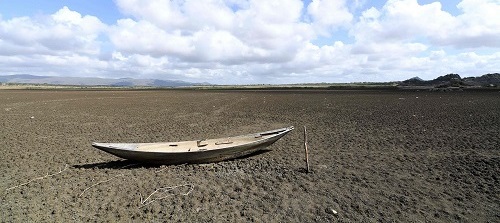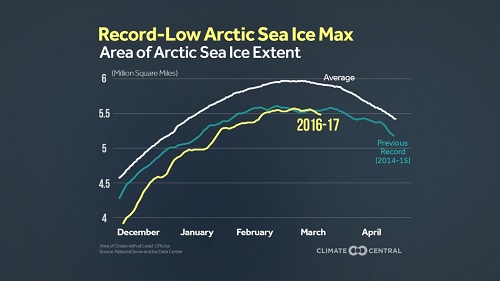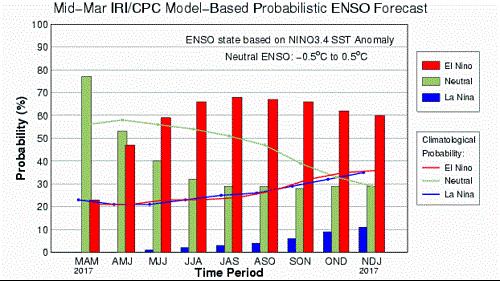2017 SkS Weekly Climate Change & Global Warming News Roundup #12
A chronological listing of news articles posted on the Skeptical Science Facebook page during the past week. Articles of signifigance as determined by the editor are highlighted in the Editor's Picks' section.
Editor's Picks
Record-breaking climate change pushes world into ‘uncharted territory’

A boat lies in the dry Cedro reservoir in Quixadá, Brazil. Climate change increases the risk of extreme weather events like drought. Photograph: Evaristo Sa/AFP/Getty Images
The record-breaking heat that made 2016 the hottest year ever recorded has continued into 2017, pushing the world into “truly uncharted territory”, according to the World Meteorological Organisation.
The WMO’s assessment of the climate in 2016, published on Tuesday, reports unprecedented heat across the globe, exceptionally low ice at both poles and surging sea-level rise.
Global warming is largely being driven by emissions from human activities, but a strong El Niño – a natural climate cycle – added to the heat in 2016. The El Niño is now waning, but the extremes continue to be seen, with temperature records tumbling in the US in February and polar heatwaves pushing ice cover to new lows.
Record-breaking climate change pushes world into ‘uncharted territory’ by Damian Carrington, Guardian, Mar 20, 2017
Fighting Ocean Pollution and Climate Change Is a Two-Front War

Speaking to Pacific island leaders and diplomats in Suva last week, the incoming President of the UN Climate Change Conference in Bonn in November (COP23), Fijian Prime Minister Voreqe Bainimarama, said his most important goal was to preserve the multilateral consensus for decisive action on climate change that was reached in the Paris Climate Change Agreement at the end of 2015.
“We cannot afford to have any government renege on the commitments that were made. Many countries face short-term domestic pressures, and there is no doubt that changing the behaviors that led us to this crisis will not be easy, but the rewards will be great. And besides, we have no choice,” he said.
The Fijian Prime Minister was speaking at a preparatory meeting for the UN Ocean Conference in June. The conference is designed to help reverse the decline in the health of world’s oceans, currently under threat from growing pollution and the impacts of climate change.
“In a very real sense, we are fighting a two-front war. One front is the fight to keep the oceans clean and to sustain the marine plant and animal life on which we depend for our livelihoods and that keep the earth in proper balance,” the Fijian leader said. “The other front is the fight to slow the growth of global warming and, unfortunately, also to adapt to the changes we know are coming - to rising seas, encroaching sea water, violent storms and periods of drought.”
Fighting Ocean Pollution and Climate Change Is a Two-Front War. by Fijian Prime Minister Voreqe Bainimarama, UNFCCC/COP-23, Mar 20, 2017
Business leaders urge G20 to put climate change back on agenda

Children play amid icebergs on the beach in Nuuk, Greenland, June 5, 2016. REUTERS/Alister Doyle
Business executives and scientists on Tuesday urged the world's leading economies to put global warming back on the G20 agenda after finance ministers and central bankers failed to reaffirm their readiness to finance measures against climate change.
The G20's outreach organizations for business (B20), think tanks (T20) and civil society groups (C20) urged the Group of 20 leading economies in a joint statement to take fast and fundamental action to counter rising temperatures.
"Climate change represents one of the largest risks to sustainable development, inclusiveness, equitable economic growth and financial stability," the statement said.
"We need to be sure that (G20 leaders) will fulfill existing international climate-related commitments, foremost the Paris Agreement," it said.
The statement was signed by B20 chair Kurt Bock, who is also CEO of chemicals group BASF BASF.DE, and several leading scientists, including Ottmar Edenhofer from the Mercator Research Institute on Global Commons and Climate Change.
Business leaders urge G20 to put climate change back on agenda by Gernot Heller & Michael Nienaber, Reuters, Mar 21, 2017
Arctic Sea Ice Sets Record-Low Peak for Third Year
Constant warmth punctuated by repeated winter heat waves stymied Arctic sea ice growth this winter, leaving the winter sea ice cover missing an area the size of California and Texas combined and setting a record-low maximum for the third year in a row.
Even in the context of the decades of greenhouse gas-driven warming, and subsequent ice loss in the Arctic, this winter’s weather stood out.

“I have been looking at Arctic weather patterns for 35 years and have never seen anything close to what we’ve experienced these past two winters,” Mark Serreze, director of the National Snow and Ice Data Center, which keeps track of sea ice levels, said in a statement.
Arctic Sea Ice Sets Record-Low Peak for Third Year by Andrea Thompson, Climate Central, Mar 22, 2017
El Niño's Odds to Return By Late Summer or Fall Increasing
The odds of El Niño's development by the late summer or early fall have increased, according to the latest output from forecast model guidance.
NOAA's Climate Prediction Center (CPC) officially declared La Niña's end in early February as sea temperatures have steadily warmed in the equatorial region of the central and eastern Pacific, and we're now in the neutral phase of the oscillation. Neutral means that neither La Niña or El Niño conditions exist.
As shown below, models currently suggest we'll be in the neutral category through the spring and into the early summer months (April-May-June, or AMJ), but after that, sea temperatures could be warm enough for El Niño conditions to take over.

The chance for various phases of El Niño, according to IRI's mid-March model-based probabilistic forecast. Red bars show the probability of El Niño's development during each three-month period. (International Research Institute for Climate and Society)
El Niño's Odds to Return By Late Summer or Fall Increasing by Jonathan Belles & Brian Donegan, WunderBlog, Weather Undergound, Mar 23, 2017
Sun Mar 19, 2017
- Budget Proposal Would Hamper Climate Efforts Abroad by John Upton, Climate Central, Mar 16, 2017
- Abnormal El Nino in Peru unleashes deadly downpours; more flooding seen by Mitra Taj, Reuters, Mar 17, 2017
- Europe Faces Annual Extreme Coastal Floods in Future by Andrea Thompson, Climate Central, Mar 15, 2017
- Coral reef survival hinges on ‘urgent and rapid’ emissions cuts by Robert McSweeney, Carbon Brief, Mar 16, 2017
- The Two Warmest Februaries on Earth Since 1880 Have Occurred the Past Two Years by Jon Erdman, Weather Underground, Mar 18, 2017
- Updated: Some 100 groups have now endorsed the March for Science by Lindzi Wensel, Science (AAAS), Mar 15, 2017
- Why I think there's still hope for the climate in 2017 by Adam Levy, Guardian, Mar 19, 2017
- #100 Climate, Climate Central, Mar 17, 2017
Mon Mar 20, 2017
- New Evidence Confirms Risk That Mideast May Become Uninhabitable by Baher Kamal, Inter Press Service (IPS), Mar 13, 2017
- The financial benefits of the EPA data Trump doesn't want you to know about by Matt Weiser, Guardian, Mar 15, 2017
- A grim budget day for U.S. science: analysis and reaction to Trump's plan, Science (AAAS), Mar 16, 2017
- Faced with rising seas, French Polynesia ponders floating islands by Sebastien Malo, Thomson Reuters Foundation, Mar 20, 2017
- Scientists Bristle at Trump Budget’s Cuts to Research by Henry Fountain & John Schwartz, New York Times, Mar 16, 2017
- Trump advisers want concessions for coal if US stays in climate pact by Andrew Restuccia, Politico, Mar 18, 2017
- 19 House Republicans call on their party to do something about climate change by Dana Nuccitelli, Climate Consensus - the 97%, Guardian, Mar 20, 2017
- The ‘Job-Killing’ Fiction Behind Trump’s Retreat on Fuel Economy Standards by John Decicco, Yale Environment 360, Mar 20, 2017
Tue Mar 21, 2017
- Global Carbon Emissions Level off Even as Economy Grows by Scott Waldman, E&E News/Scientific American, Mar 20, 2017
- On front line of climate change as Maldives fights rising seas by Nenad Jari? Dauenhauer, New Scientist, Mar 20, 2017
- Atlantic City and Miami Beach: two takes on tackling the rising waters by Oliver Milman, Guardian, Mar 20, 2017
- Record-breaking climate change pushes world into ‘uncharted territory’ by Damian Carrington, Guardian, Mar 20, 2017
- The coal industry is sick — and it's terminal by Shane Savitsky, Axios, Mar 21, 2017
- Canberra geologist helps advance global understanding of climate change by Finbar O'Mallon, Canberra Times, Mar 20, 2017
- Trump Lays Plans to Reverse Obama’s Climate Change Legacy by Coral Davenport, New York Times, Mar 21, 2017
- Why global warming could lead to a rise of 100,000 diabetes cases a year in the U.S. by Karen Kaplan, Los Angeles Times, Mar 20, 2017
Wed Mar 23, 2017
- Philippines' Ratification of Paris Agreement Cheers Climate World by Zahra Hirji, InsideClimate News, Mar 21, 2017
- The unnamed phenomenon behind Peru’s extraordinary flooding by Angela Fritz, Capital Weather Gang, Washington, Mar 20, 207
- Fighting Ocean Pollution and Climate Change Is a Two-Front War. by Fijian Prime Minister Voreqe Bainimarama, UNFCCC/COP-23, Mar 20, 2017
- Georgia Tech research says global climate change may worsen China’s severe air pollution problems by Larry Gierer Ledger-Enquirer, Mar 19, 2017
- 5 ways to think about the remarkable slowdown in global CO2 emissions by Brad Plumer, energy & Environment, Vox, Mar 21, 2017
- Business leaders urge G20 to put climate change back on agenda by Gernot Heller & Michael Nienaber, Reuters, Mar 21, 2017
- Global warming is increasing rainfall rates by John Abraham, Climate Consensus - the 97%, Guardian, Mar 22, 2017
- Ice at Both Poles Shrinks to Record Lows by Sabrina Shankman, inside Climate News, Mar 22, 2017
Thu Mar 24, 2017
- Provinces considering carbon pricing watch Ontario's first cap-and-trade auction by Allison Jones, Canada Press/National Observer, Mar 21, 2017
- Trump's Words Could Jeopardize His Environmental Rollbacks, Too by Jennifer A Dlouhy, Bloomberg News, Mar 22, 2017
- Smog Will Choke Crops If Climate Plan Is Scrubbed by Ashley Braun, Scientific American, Mar 22, 2017
- Judge Orders Exxon to Turn Over Tillerson's 'Wayne Tracker' Climate Emails by David Hasemyer, InsideClimate News, Mar 22, 2017
- Seven things that need to happen to keep global temperature rise below 2C by Jocelyn Timperley, Carbon Brief, Mar 21, 2017
- Coal's Steep Decline Keeps Climate Goal Within Reach, Report Says by Sabrina Shankman, InsideClimate News, Mar 22, 2017
- State Department to approve Keystone pipeline permit on Friday: sources by Valerie Volcovici & Timothy Gardner, Reuters, Mar 23, 2017
- Analysis: Dramatic shift in UK government outlook for gas and clean energy by Simon Evans, Carbon Brief, Mar 22, 2017
Fri Mar 25, 2017
- Peru's deadly floods ring alarm bell for Latin America cities by Anastasia Moloney, Thomson Reuters Foundation, Mar 23, 2017
- Northern Lights: Large-Scale Solar Power Is Spreading Across the U.S. by Cheryl Katz, Yale Environment 360, Mar 23, 2017
- The Fight is Not Over,' Groups Vow, as State Dept Poised to Approve Keystone XL by Nika Knight, Common Dreams, Mar 23, 2017
- Breitbart's James Delingpole says reef bleaching is 'fake news', hits peak denial by Graham Readfearn, Planet Oz, Guardian, Mar 23, 2017
- Shock mass coral die-off in Asia sounds alarm for world’s reefs by Alice Klein, New Scientists, Mar 23, 2017
- These extreme weather events show that our climate is in ‘uncharted territory’ by Alex Gray, World Economic Forum, Mar 24, 2017
- El Niño's Odds to Return By Late Summer or Fall Increasing by Jonathan Belles & Brian Donegan, WunderBlog, Weather Undergound, Mar 23, 2017
- Why the World Economy Has to Be Carbon Free by 2050, Opinion by John Rocksom, New York Times, Mar 23, 2017
Sat Mar 26, 2017
- Sea ice falls to record lows in both the Arctic and Antarctic by Roz Pidcock, Carbon Brief, Mar 22, 2017
- Lamar Smith, unbound, lays out political strategy at climate doubters’ conference by Jeffery Mervis, Science (AAAS), Mar 24, 2017
- Keystone XL: Trump issues permit to begin construction of pipeline by Amber Jamieson & Adam Vaughan, Guardian, Mar 24, 2017
- 20 Common Myths That Climate Scientists Often Hear, Opinion by Marshall Shepard, Forbes, Mar 24, 2017
- Elevator Pitches - Chapter 02 - Radiative Gases by Rob Honeycutt, Skeptical Science, Mar 24, 2017
- Arctic Sea Ice Sets Record-Low Peak for Third Year by Andrea Thompson, Climate Central, Mar 22, 2017
- Diet, Including Eating Less Beef, Dropped Americans' Carbon Emissions by 9% by Georgina Gustin, InsideClimate News, Mar 23, 2017
- House Science Committee to hold climate change hearing from which we’ll learn nothing by Jason Samenow, Capital Weather Gang, Washington Post, Mar 24, 2017
Posted by John Hartz on Saturday, 25 March, 2017






